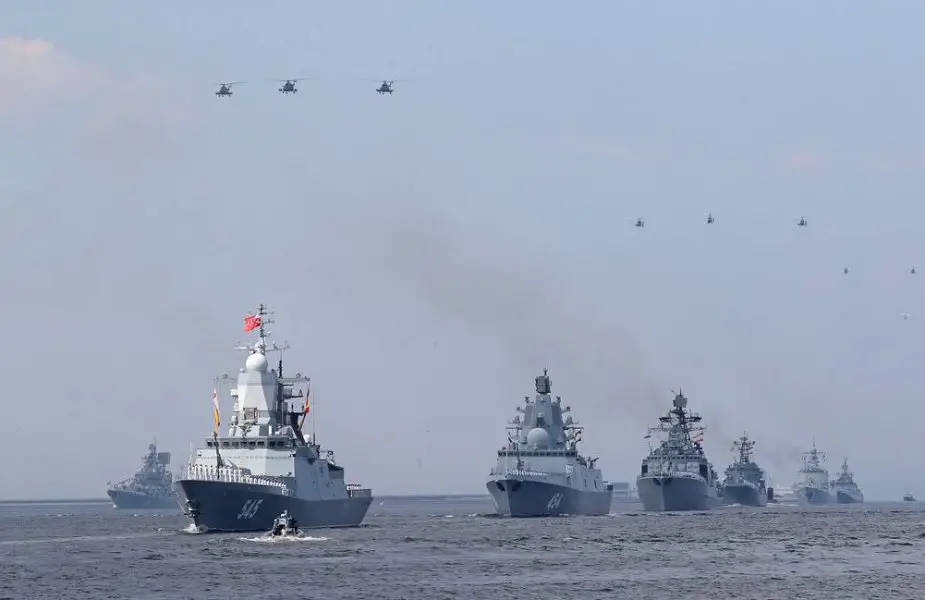Analysis: latest Russian Navy contracts offer development conclusions
The contracts signed at Army-2020 forum and exhibited models of warships provide conclusions on Navy development guidelines, the Izvestia daily writes.
Follow Navy Recognition on Google News at this link
 Illustration picture: about 200 combat ships to take part in parades on Russia’s Navy Day. (Picture source: Alexander Demianchuk/TASS)
Illustration picture: about 200 combat ships to take part in parades on Russia’s Navy Day. (Picture source: Alexander Demianchuk/TASS)
The main announcements related to surface shipbuilding. The Defense Ministry ordered two frigates of project 22350 which are to become the ninth and tenth warships of the series. The Northern and Pacific fleets are expected to get four frigates each by 2027 and the Black Sea fleet will receive two frigates. The warships will reinforce the Russian blue-water fleet which currently operates ships built in 1980 - early 1990s.
The contract for two frigates was expected, but the deal for a record batch of corvettes was a surprise. The Navy ordered ten ships. Eight of them will be built by project 20380. The corvettes have an upgraded construction, arms and seaworthiness. The Sovershenny and the Gromky corvettes of the Pacific fleet have recently made a long ocean sortie. Most new corvettes will also operate in the Far East.
Eight project 20380 corvettes will have a new integrated mast with Zaslon radar. It has been already installed on four corvettes under construction.
Two other corvettes belong to project 20385. The Gremyashchy lead corvette is undergoing trials. In contrast to project 20380, they are armed with Kalibr missiles. The order of another two corvettes demonstrates the success of the Russian program to replace imported power plants. The lead pair of the corvettes had to be powered by German engines.
The Navy earlier planned to procure project 20386 corvettes. The return to project 20380 can mean that the design of the innovative project, its cost and the creation of container arms encountered difficulties. The onboard placement of prospective weapons, transportation and personnel training have not been finalized and the Navy decided to order available corvettes and weapons for them. Still the 20386 program likely remains vital despite delays.
"In 2020, the fleet revised its development program in favor of tested warships, submarines and arms," expert Vladislav Shurygin said. "It can be seen from the procurement of project 20380 corvettes and project 636.3 submarine. It was previously believed the projects had been completed," he said.
Financial problems and difficulties with new arms and hardware likely postpone prospective projects. The Navy plans to build up and replace outdated warships and submarines as soon as possible by tested warships. It also plans to reinforce the Arctic group, the expert said.
The contract for a series of project 12700 minesweepers was expected. Three warships are already operational and five are under construction. The Navy is likely satisfied with the project and wants to continue it. Today, Soviet-built warships comprise the backbone of the minesweeping force. They are unfit against modern sea mines.
Admiralty Shipyard received a contract for the sixth submarine of project 677. The St. Petersburg lead sub has joined the Navy and is undergoing test operation. The USC encountered difficulties in construction. However, the contract shows the Defense Ministry continues effort to form a fully-fledged brigade of submarines of the class. There were reports that all project 677 submarines will operate in the Baltic fleet.
The Russian Navy usually orders six submarines which is a typical brigade force. Therefore, the information on one project 636.3 sub was a surprise. It will bring the total number of submarines of the family to 13. The submarine is likely to operate in the Baltic fleet which currently has only the Dmitrov submarine. It is used for training of antisubmarine forces and crews for new submarines.
The Defense Ministry also signed a contract with Zvyozdochka Shipyard on the overhaul and upgrade of project 971 nuclear submarines. There are four submarines of the project at the shipyard in Severodvinsk - the Samara and the Bratsk of the Pacific fleet and the Volk and the Leopard of the Northern fleet. They have stayed idle for six years. The contract for their overhaul and upgrade will return the nuclear submarines back to service, the Izvestia said.
© Copyright 2020 TASS Navy Recognition. All rights reserved. This material may not be published, broadcast, rewritten or redistributed.


























